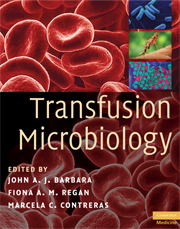Book contents
- Frontmatter
- Contents
- List of contributors
- Foreword
- Preface
- Acknowledgements
- Glossary
- Introduction: Transfusion-transmitted infections, then and now
- Section 1 Agents
- Section 2 Selection and testing
- 10 Blood donor selection and qualification
- 11 Current serological methods of testing and automation
- 12 Confirmatory testing and donor re-admission
- 13 The strategy for applications of nucleic acid testing
- 14 Nucleic acid testing: general view
- 15 Nucleic acid testing: the US approach
- 16 Nucleic acid testing: the UK approach
- 17 Quality in the screening of donations for transfusion-transmissible infections
- 18 Microbiological blood testing and new technologies
- 19 Processing and components: leucodepletion and pathogen reduction
- 20 Fractionated products
- Section 3 Surveillance, risk and regulation
- Index
- Plate section
- References
15 - Nucleic acid testing: the US approach
from Section 2 - Selection and testing
Published online by Cambridge University Press: 12 January 2010
- Frontmatter
- Contents
- List of contributors
- Foreword
- Preface
- Acknowledgements
- Glossary
- Introduction: Transfusion-transmitted infections, then and now
- Section 1 Agents
- Section 2 Selection and testing
- 10 Blood donor selection and qualification
- 11 Current serological methods of testing and automation
- 12 Confirmatory testing and donor re-admission
- 13 The strategy for applications of nucleic acid testing
- 14 Nucleic acid testing: general view
- 15 Nucleic acid testing: the US approach
- 16 Nucleic acid testing: the UK approach
- 17 Quality in the screening of donations for transfusion-transmissible infections
- 18 Microbiological blood testing and new technologies
- 19 Processing and components: leucodepletion and pathogen reduction
- 20 Fractionated products
- Section 3 Surveillance, risk and regulation
- Index
- Plate section
- References
Summary
The central goal of blood centres is to provide a safe, adequate and effective blood supply. Towards that end, the focus on infectious disease testing has resulted in a high level of blood component safety. Today, in the developed world, the risk of transfusion-transmission of a major agent has been dramatically reduced by the introduction of next generation tests for antibodies and antigens, and with the introduction of nucleic acid testing (NAT). In the USA, with the introduction of NAT, the residual risk of HIV-1 and HCV has been reduced to approximately 1:2,000,000 donations screened (Dodd and Stramer, 2000). The yield of HIV-1 infected donors detected by NAT has been reported at 1:3.1 million and that for HCV (relative to third-generation antibody screening) at 1:270,000 (Stramer et al., 2004). The low frequency of these findings reinforces the safety of the blood supply today. In addition, the specificity of HIV-1 and HCV NAT relative to providing a false-positive result to a blood donor has been exceedingly high, with lower false-positive rates than any of the serological tests used in blood donor screening (e.g. 1:40,000 for NAT for the American Red Cross, ARC).
In addition to recipient safety, another aspect of the blood donation testing process is that it serves a public health function in identifying those individuals who are infected by a disease agent, particularly at the time shortly following exposure.
- Type
- Chapter
- Information
- Transfusion Microbiology , pp. 203 - 208Publisher: Cambridge University PressPrint publication year: 2008



